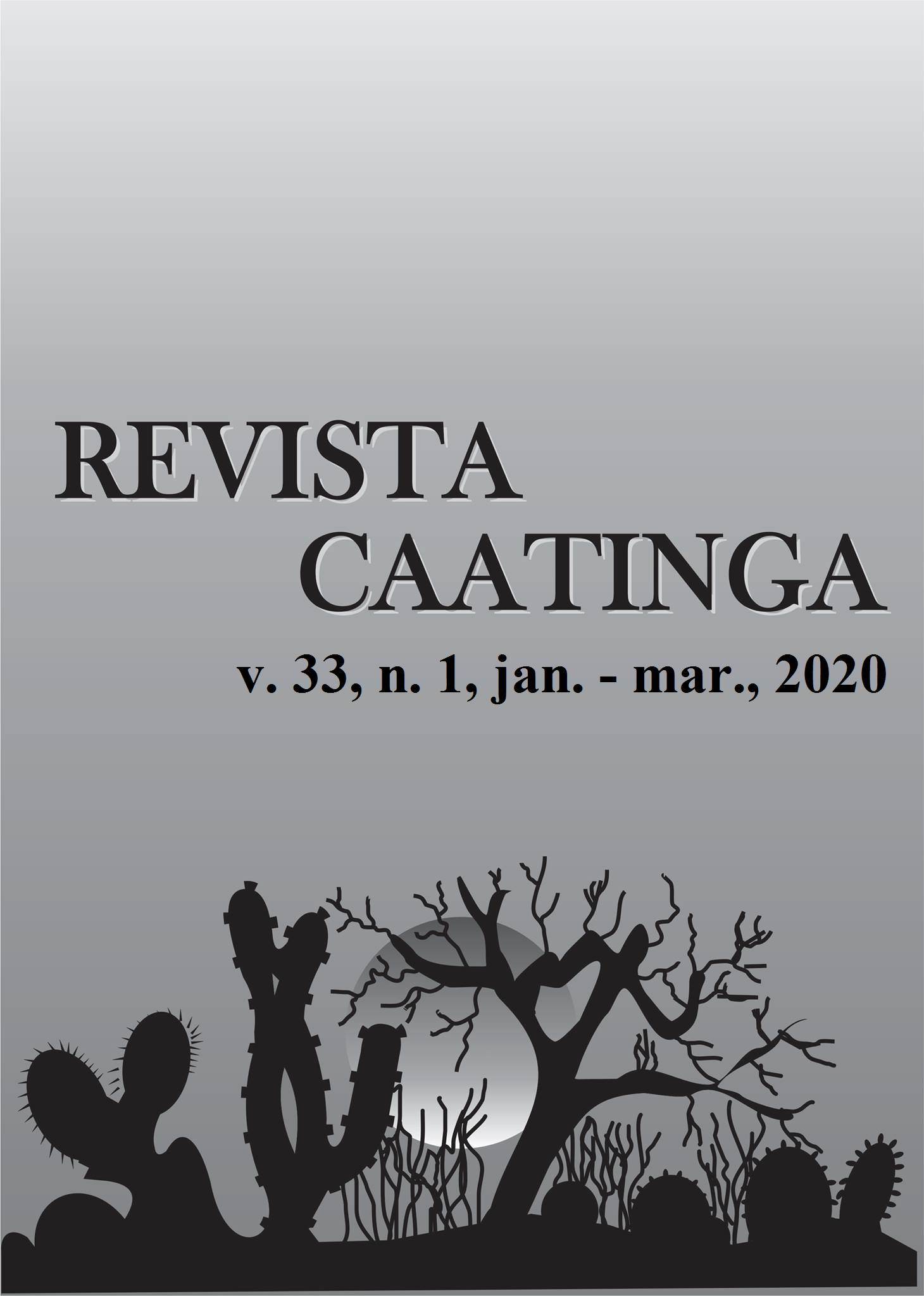ALLELOPATHIC ACTIVITY OF Amburana cearensis SEED EXTRACTS ON MELON EMERGENCE
DOI:
https://doi.org/10.1590/1983-21252020v33n130rcKeywords:
Allelochemistry. Coumarin. Fractionation of extracts. Phytochemical prospection.Abstract
Amburana cearensis is a species rich in coumarin, a phenolic compound that is a natural inhibitor of the germination process. In Caatinga, this species occurs in areas where melons are cultivated, and even after deforestation, they may be present in the soil seed bank. The aim of this study was to investigate the allelopathic activity of A. cearensis aqueous seed extract fractions on the emergence of melons and to carry out photochemical analyses of the extracts. Four experiments were carried out based on the fractionation of the seed extract: E1 - hexane fraction, E2 - dichloromethane fraction, E3 - ethyl acetate fraction, and E4 - aqueous fraction. The statistical design was completely randomized, with four replicates, each having 20 seeds. The treatments were composed of different extract concentrations (1, 0.5, 0.25, 0.125, and 0%) and phytochemical prospecting of the extracts obtained during fractionation was performed. The extracts obtained from the hexane fraction affected the emergence and initial development of melon seedlings. The dichloromethane, ethyl acetate, and aqueous extracts had negative effects on the formation of dry matter, shoots, and roots, with the highest concentrations prompting the most negative effects. Coumarin was present in all extracts, but its concentration was highest in the hexane fraction, which was consequently characterized as highly phytotoxic during the bioassays.
Downloads
References
ALMEIDA, J. R. G. S. et al. Amburana cearensis – uma revisão química e farmacológica. Scientia Plena, 6: 1-8, 2010.
AYERS, R. S.; WESTCOT, D. W. Water Quality for Agriculture, Irrigation and Drainage Paper, 29 Rev. 1 (Reprinted 1989, 1994). 1994.
BRASIL. Ministério da Agricultura e Reforma Agrária. DNPV. Divisão de Sementes e Mudas. Regras para Análise de Sementes. Brasília: Mapa, 2009, 399 p.
CANUTO, K. M.; LIMA, M. A. S.; SILVEIRA, E. R. Amburosides C-H and 6-O-protocatechuoyl coumarin from Amburana cearensis. Journal of the Brazilian Chemical Society, 21: 1746-1753, 2010.
COELHO, M. F. B. et al. Atividade alelopática de extrato de sementes de juazeiro. Horticultura Brasileira, 29: 108-111, 2011.
FELIX, R. A. Z. et al. Efeitos Alelopáticos da Amburana cearensis L. (Fr.All.) AC Smith na Germinação de Sementes de Alface (Lactuca sativa L.) e de Rabanete (Raphanus sativus L.). Revista Brasileira de Biociências, 5: 138-140, 2007.
FORMAGIO, A. S. N. et al. Potencial alelopático de cinco espécies da família Annonaceae. Revista Brasileira de Biociências, 8: 349-354, 2010.
INOUE, M. H. et al. Avaliação do potencial alelopático de substâncias isoladas em sementes de araticum (Annona crassiflora). Planta Daninha, 28: 735-741, 2010.
JABRAN, K. Manipulation of allelopathic crops for weed control. Dordrecht: Springer, 1 ed. 2017, 87 p.
LORENZI, H. Árvores Brasileiras: manual de identificação e cultivo de plantas arbóreas nativas do Brasil. 6. ed. Nova Odessa, SP: Instituto Plantarum, 2014. 384 p.
MAGUIRE, J. D. Speeds of germination-aid selection and evaluation for seedling emergence and vigor. Crop Science, 2: 176-177, 1962.
MALHEIROS, R. S. P. et al. Atividade alelopática de extratos de Lafoensia pacari A. ST.-HIL. sobre Lactuca sativa L. e Zea mays L. em condições de laboratório. Revista Brasileira de Agroecologia, 9: 185-194, 2014.
MATOS, J. F. A. Introdução a fitoquímica experimental. 3. ed. Fortaleza, CE: Edições UFC, 2009. 150 p.
OLIVEIRA, A. K. et al. Alelopatia de extratos de espécies da caatinga sobre sementes de meloeiro. Semina: Ciências Agrárias, 37: 557-566, 2016.
PEREIRA, K. C. L. et al. Potencial alelopático do extrato etanólico de Anacardium humile A.St.-Hil. (cajuzinho-do-cerrado) na germinação e formação de plântulas de Lactuca sativa L. (alface), Lycopersicon esculentum Mill. (tomate) e Senna obtusifolia (L.) Irwin & Barneby (fedegoso). Gaia Scientia, 12: 144-160, 2018.
RICE, E. L. Allelopathy. London: Academic Press, 1984. 413 p.
RODRIGUES, I. M. C. et al. Prospecção química de compostos produzidos por Senna alata com atividade alelopática. Planta Daninha, 28: 1-12, 2010.
SILVEIRA, P. F.; MAIA, S. S. S.; COELHO, M. F. B. Potencial alelopático do extrato aquoso de folhas de Mimosa tenuiflora (Willd.) Poir. na germinação de Lactuca sativa l. Bioscience Journal, 28: 472-477, 2012.
SOUZA FILHO, A. P. S.; FONSECA, M. L.; ARRUDA, M. S. P. Substâncias químicas com atividades alelopáticas presentes nas folhas de Parkia pendula (Leguminosae). Planta Daninha, 23: 565-573, 2005.
SOUZA FILHO, A. P. S. et al. Atividade alelopática de extratos brutos de três espécies de Copaifera (Leguminosae-Caesalpinioideae). Planta Daninha, 28: 743-751, 2010.
TAIZ, L. et al. Fisiologia e Desenvolvimento Vegetal. 6. ed. São Paulo, SP: Artmed, 2017. 888 p.
YAMAGUSHI, M. Q.; GUSMAN, G. S.; VESTENA, S. Allelopathic effect of aqueous extracts of Eucalyptus globulus Labill. and of Casearia sylvestris Sw. on crops. Semina: Ciências Agrárias, 32: 1361-1374, 2011.
Downloads
Published
Issue
Section
License
Os Autores que publicam na Revista Caatinga concordam com os seguintes termos:
a) Os Autores mantêm os direitos autorais e concedem à revista o direito de primeira publicação, com o trabalho simultaneamente licenciado sob a Licença Creative Commons do tipo atribuição CC-BY, para todo o conteúdo do periódico, exceto onde estiver identificado, que permite o compartilhamento do trabalho com reconhecimento da autoria e publicação inicial nesta revista, sem fins comerciais.
b) Os Autores têm autorização para distribuição não-exclusiva da versão do trabalho publicada nesta revista (ex.: publicar em repositório institucional ou como capítulo de livro), com reconhecimento de autoria e publicação inicial nesta revista.
c) Os Autores têm permissão e são estimulados a publicar e distribuir seu trabalho online (ex.: em repositórios institucionais ou na sua página pessoal) a qualquer ponto antes ou durante o processo editorial, já que isso pode gerar alterações produtivas, bem como aumentar o impacto e a citação do trabalho publicado (Veja O Efeito do Acesso Livre).







